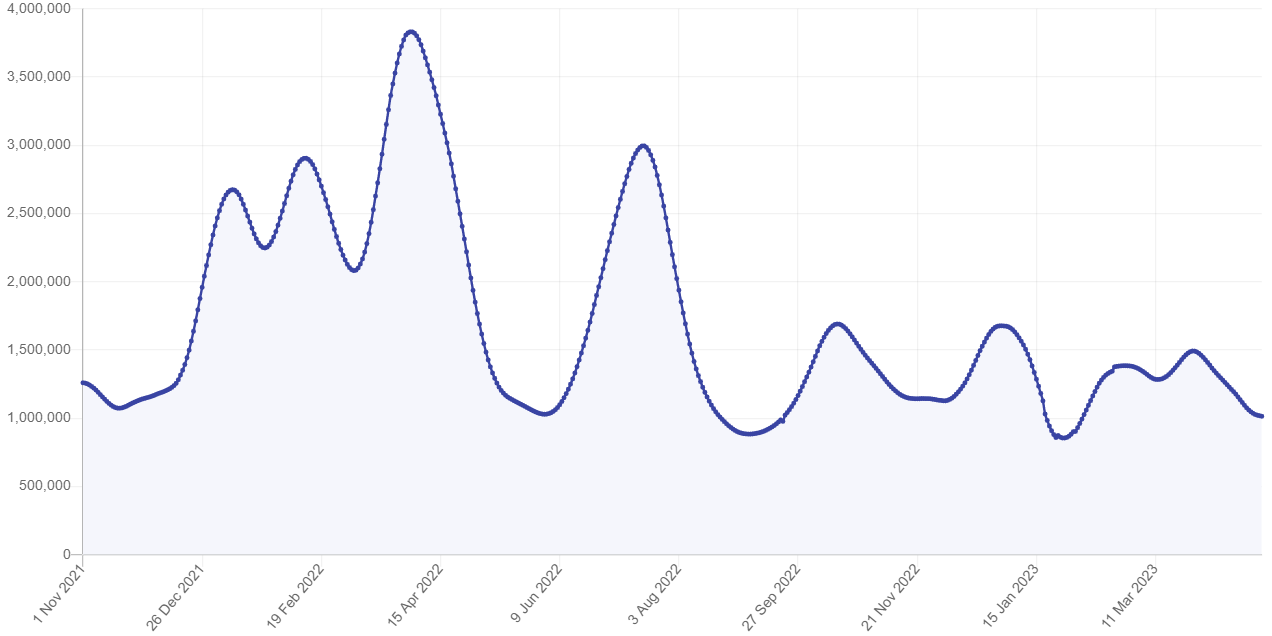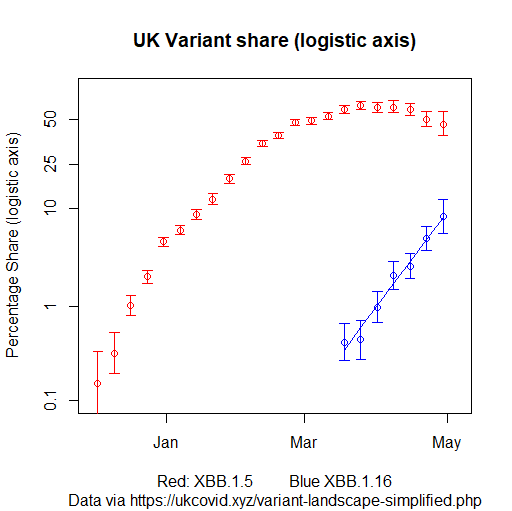I’m desperately trying to stay off the COVID beat, but it’s hard to do that when I keep seeing stuff like this reported in the papers:
Face masks should be worn again on public transport, experts say, as the Arcturus Covid variant continues to spread.
Professor Stephen Griffin, chair of Independent Sage, said that people should go back to testing regularly and wearing face masks to protect from the virus.
To be clear, I’m not some kind of inveterate culture-war-fighting let-it-rip anti-masker. I wore them in supermarkets (when unvaccinated) for several months before that was a legal requirement in the UK, and I’m extremely sceptical of the quality of papers that purport to show them causing damaging oxygen deprivation or being responsible for Long COVID symptoms.
My view is that masks probably do reduce the spread of COVID, but not to a huge extent. As a result, I fear that this call for the general public to wear masks on public transport is likely to have an extremely limited impact on the future trajectory of infections, and may even be counterproductive in the long term. (Masks in healthcare settings and for clinically vulnerable people are a separate matter).
This is based on a view that adherence to what Professor Griffin1 proposes is likely to be a) limited in the number of people acting b) short-term at best. I think any analysis based on “if everyone just wore fit-tested N95s for several months” isn’t going to fly. People aren’t “just” going to do that, or at least not without an absolutely compelling reason to (for example, a variant that was spreading as fast as early strains of omicron and was as deadly in our current highly-immune population as delta was in a naive one - and it seems clear that XBB.1.16 is not that).
I work on a University campus, and mask adherence there is currently clearly very low, even among groups of people who continued to wear them long after it was no longer a legal requirement. I think we have to be realistic about how well the levers work, over three years since we first went into lockdown.
Mixed messages from ISAGE
Part of the problem is that it seems hard to tell whether Professor Griffin is speaking for Independent SAGE, or just on his own behalf. I think the chances of significant mask uptake based on a call from Independent SAGE are pretty minimal anyway (while they have 200k followers on Twitter, they haven’t exactly been setting public health priorities lately). But if it’s just one member calling for this on his own account, then the chances are even lower.
And I think the position presented by Professor Pagel in the Independent SAGE briefing on Friday is probably the correct one:
I agree with the analysis there, that this new XBB.1.16 variant is unlikely to cause a big wave (I’m not calling it Arcturus by the way, because the WHO have firmly and specifically requested that people don’t do that).
But is this “no big wave” the official Independent SAGE position, or when other ISAGE members say things like
schools may be forced to close if significant numbers of children start falling ill
is that what they really think? It’s hard to tell, and that’s not helpful, because clear messaging is essential.
Likely trajectory of XBB.1.16
As I previously described here I think it’s likely that XBB.1.16 will cause a resurgence in numbers, but not a huge one. Although we have less data than before, it is still possible to do some kind of analysis of the numbers that we do have, so it’s not pure guesswork.
In fact, we really only need to put two numbers together: firstly admissions have been falling around 15% per week lately, so we can take that as an estimate of the current growth rate of the currently dominant XBB.1.5 variant.
Secondly, the invaluable Alex Selby is still managing to pull data from COG-UK somehow, and he estimates that XBB.1.16 has a daily advantage of about 7% over XBB.1.5 in the UK at the moment. Putting this together, it might suggest that XBB.1.16 is growing about 36% per week in absolute numbers in the UK (1.07^7*0.85 = 1.36), albeit with something of a wide margin of error.
Converting this estimate into an R number requires assumptions about generation time, but if we guess 3 generations per week then you can take the cube root and get an R number of 1.11, 2 generations per week gives 1.17. So perhaps we can split the difference and suggest that the R number of pure XBB.1.16 may be about 1.15?
It certainly doesn’t seem terrifying, compared with some of the numbers we’ve heard in the past. And it’s worth noticing there’s a tradeoff based on this estimate: if R is higher it is less likely that masks will stop it in its tracks, if it is lower then the resulting wave will be smaller than we would otherwise assume.
Effect of masks
So, the obvious question is, what effect is Professor Griffin’s call for masks on public transport likely to have? If we are optimistic, we might imagine that 20% of people might take it up. We might imagine that 20% of peoples’ contacts are on public transport (personally I think this is a big overestimate, now that people have returned to something close to their normal pattern of life). We might hope that masks are perfectly effective and stop all infections (again, this relies a lot on people wearing more than just cloth or surgical masks).
So under extremely optimistic assumptions, we’ve just saved 20% of 20%, or 4% of total infections. We’ve taken the R number from 1.15 down to 1.11. We certainly haven’t got it under 1, which is what we’d need to do to stop exponential growth. To do that, we’d need to cut out 13% of daily contacts. It’s doable, we managed more than that before, but there was a clear rationale in terms of preventing the NHS from being overwhelmed, financial support in place to help people isolate and legal restrictions on human behaviour being enforced by the police.
At best then, we would reduce the herd immunity threshold for this variant somewhat, and reduce the size of the total wave as result - from something like 13% of the population to 10%. But crucially, that assumes that people would continue to take these measures for a significant length of time.
Playing the long game
My feeling is that any resurgence in mask wearing is likely to be short-lived. Early in the COVID pandemic, behavioural psychologists were concerned that NPIs could not be effective for a long period of time because adherence would slip. While this turned out to not be true in Spring 2020 and Winter 2021, there was a clear and present danger at the time with many hundreds of daily COVID deaths being constantly reported.
Whereas now, understandably, COVID fatigue has set in among the majority of the population. There was a return to mask wearing when omicron first arrived in the UK in December 2021 and was somewhat of an unknown quantity. However, given that most people have had at least one omicron infection since then and the NHS has survived, it seems hard to imagine that mask usage would be sustained for more than a few weeks, particularly as the weather warms up and the Tube and buses get hot.
In terms of the trajectory, a temporary reduction in R doesn’t buy us very much. If people wore masks for 3 weeks and then stopped, the R number would return to something close to its present level (slightly lower because we would have gained some immunity in the meantime), and things would pick up again more or less as before. A short-term return to masks in the growth phase doesn’t buy much more than a delay.
This isn’t a new observation! It was built into (Actual) SAGE’s own analysis of 4th March 2020:
Behavioural and social interventions which moderately reduce transmission are unlikely to greatly reduce the total number of cases but could reduce and slightly delay the peak.
In fact, if we were to return to masks for a brief period, the most effective time to do it would be close to any peak, if judged necessary at the time - it could cut off the worst pressure on the NHS, reduce overshoot of infections, and have the biggest overall effect on reducing admissions. In contrast, putting in what is likely to be a short-term measure at the trough of infections (as Professor Griffin urges) is likely to have little effect on things.
In fact, arguably these measures could even erode trust in public health in the future. While people have done remarkable things in terms of personal sacrifices during lockdown, isolating when not legally required and collectively achieving higher rates of vaccination than expected, I don’t think it’s wise to assume that their goodwill is infinite.
Extraordinary measures require an extraordinary rationale, and since Independent SAGE’s own analysis says that any XBB.1.16 wave is unlikely to be a big one, it’s hard to understand why this is the right time for these measures, given that we can only go to the well so many times before a “crying wolf” effect takes over completely.
(Update: 1/5/23)
Thanks to a message from Dave McNally (@OliasDave on Twitter), I have been able to independently verify Alex’s estimates of relative growth rate. That is, here is a plot on logistic axes of the weekly percentage shares, along with confidence intervals.
As described in the linked Plus article, the standard model suggests straight line growth on this plot (for a variant with a consistent advantage), and you can see that a straight line fit does a good job. The slope corresponds to an 8% daily advantage (so slightly faster than Alex was getting, but very much in the same ballpark). You can see that this relative growth rate is similar to that seen from XBB.1.5 earlier in the year, suggesting a similar size wave, and certainly smaller than we saw for BA.1 and BA.5 previously.
My figure of “20% of contacts being on public transport” was very much pulled out of thin air. In fact, the more I think about it, the more I think that it may be an overestimate - if nothing else, because most people don’t even go on public transport! (I think it may be an example of perceptions not being accurate, particularly based around London). For example, pre-pandemic data suggests people were making 855 trips a year by private transport (including car, bike and walking) and 97 by public transport. In other words, the average person made 1 return journey a week by public transport, strongly suggesting that opportunities for infection there would be a small fraction of their overall week.
Full disclosure: I have had disagreements with Professor Griffin in the past. He used to follow me on Twitter, but I blocked him following an extremely nasty personal attack from someone he is friendly with. Personally I don’t think my judgement in this article is affected by this, but feel free to take the whole thing with a pinch of salt if you like.







I'm an idiot, could've had the variant landscape still running for the past month. I shut down most of the processes that do the update as I assumed they would stop providing all the data. I am using a slightly different dataset to Alex but thought I'd just check in case it was all still going.
https://ukcovid.xyz/variant-landscape.php
Thank you. Always a voice of reason.